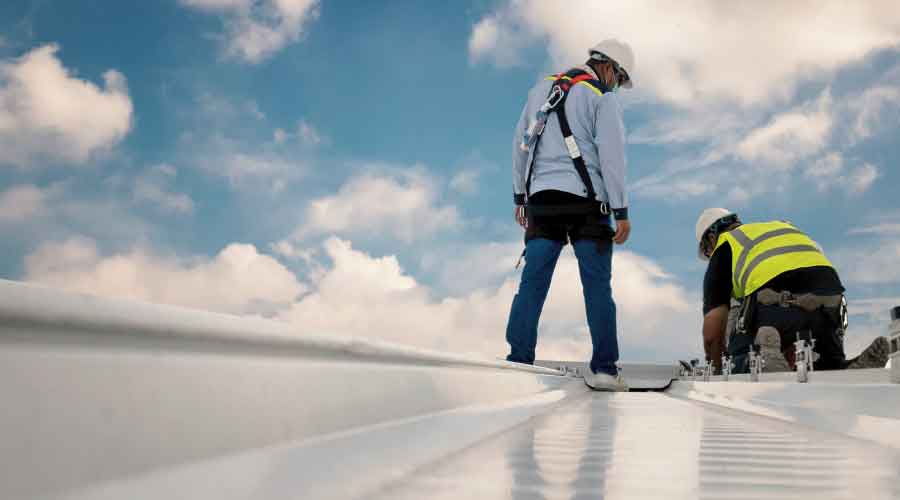Manufacturers Speak Out
Manufacturers of single-ply roofing systems discuss customer expectations, specification insights and maintenance
In Conjunction With SPRI
Sheet Membrane and Component Suppliers to the Commercial Roofing Industry
Since the arrival of single-ply roofing systems, manufacturers have significantly enhanced single-ply, or flexible membrane, systems and broadened the array of products and services they offer.
Many changes have come in response to an increase in manufacturer and end-user awareness of issues such as the environmental impact of roofs, energy efficiency, and long-term performance. Maintenance managers can more successfully specify and maintain flexible-membrane roofs by tapping into manufacturers’ knowledge of roofing-system materials and application methods.
Performance Progress
Market changes in institutional and commercial facilities in the past two decades include a growing desire to minimize environmental impact and cut energy-related costs. These changes have resulted in new technologies and improved the performance of flexible membrane systems, says Shawn Stanley, marketing director for IB Roof Systems.
“Twenty years ago, a roof system was designed to just keep the building dry,” Stanley says. End users today need a roof to do much more.
Increasingly, it needs to be energy efficient, reflective and environmentally friendly, he says.
Besides meeting these needs, manufacturers of single-ply roofing systems also are striving to improve installation by developing more reliable products and application methods.
“Manufacturers are constantly trying to build systems that make installation a lot easier and a little more fool-proof,” says Paul Oliveria, manager of specialty roofing systems at Firestone Building Products. “Anytime you can reduce the number of steps someone has to do, you end up with a better overall product.”
With this growing array of products, end users might find it more challenging to specify systems that meet facility needs. But they shouldn’t assume that all products of similar types are equal, says Steve Moskowitz, vice president of technical and warranty services at Stevens Roofing Systems.
“They need to do their homework,” Moskowitz says. Manufacturers suggest managers examine each building’s unique characteristics to determine the organization’s roofing needs before making a purchasing decision.
“Roof selection is a backward process because selecting the roof should be the last step.” Oliveria says.
Managers first should determine the goals of the reroofing project, such as improving energy efficiency. They also will need to gather information on the frequency of work on rooftop equipment that contractors and in-house workers perform. Also, a building’s geographic location and height will play a large role in determining the most appropriate roofing system.
Contractor Considerations
As flexible membrane roofing systems have evolved, so have the offerings from many roofing contractors. For example, to better serve customers, many contractors have become more familiar with the systems, specifications and application techniques related to flexible membrane systems, Oliveria says.
Contractors also have expanded beyond their traditional roles as installers and now offer a broader array of services, says Helene Pierce, director of contractor services at GAF Materials Corp.
“Compared to 10 to 15 years ago, contractors today are offering different maintenance alternatives more often to facility owners,” she says, adding that they sometimes now provide building managers more roofing-related advice. Recognizing the growing need for roof-management services and information about roofing systems, many contractors have set up maintenance divisions within their companies, Oliveria says.
Flexible Membrane Maintenance
Manufacturers of flexible membrane systems emphasize that a roofing system is only as reliable as the inspection and maintenance that take place after installation.
Roofing systems that are well maintained achieve longer-term performance, so maintenance managers must work with manufacturers to develop a roof-inspection program that helps ensure long-term performance.
“Put together a good roof-maintenance program, check it periodically, and you’ll save yourself a lot of headaches.” Oliveria says.
Adds Pierce, “If the roofing inspections are done in the spring, any maintenance needs can be done during the prime roofing months.” Then, if maintenance personnel do another inspection in the fall, they can verify that the roof is ready for the harsher winter months, she says.
“A lot of people will say they don’t have time to do roofing inspections, but if they just look to see if anything needs to be done or if anything doesn’t look right, they could avoid major problems,” Pierce says. “It’s much better to take care of any problems before water enters the roofing system.”
Roof damage also can occur when contractors or in-house workers install or repair rooftop equipment and do not properly protect the roofing system, Moskowitz says.
“They pull panels off, and instead of laying them down gently or putting protection mats down, they just drop them, and the corner digs into the roof,” Moskowitz says. “No roofing system is maintenance free.”
Flexible membrane roofing technology will continue to evolve, as will the role of manufacturers in helping managers ensure the products’ long-term performance. Managers who stay attuned to these changes will have a better chance of making smart roof-related decisions for their facilities.
Spotlight: SPRI
SPRI has devoted considerable resources to developing and canvassing a number of standards published with the American National Standards Institute (ANSI). ANSI/SPRI standards are used to develop job specifications or evaluate product performance.
SPRI developed the first national standard for retrofit roof drains. Designated ANSI/SPRI RD-1 2003, Standard for Retrofit Roof Drains, it details measures that managers should take to achieve leak-free connections to existing drain piping and to provide sufficient drainage.
SPRI recently published the seventh version of its manual, Flexible Membrane Roofing; A Professional's Guide to Specifications, which includes generic installation details and adhesive information. It is available on CD-ROM.
For information, contact SPRI at 77 Rumford Ave., Suite 3B, Waltham, MA 02453; (781) 647-7026 or info@spri.org
|
Related Topics:











